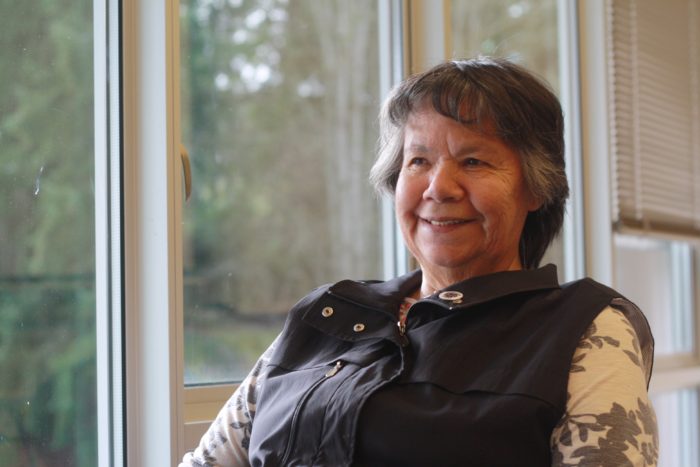Work begins to restore Coast Salish place names on mid-Island
Photo and story by Julie Chadwick
For Snuneymuxw Elder Geraldine Manson (C-tasi:a), what’s now commonly known as Mount Benson is more than just a place to take the dog for a walk and enjoy the view. To her, Mount Benson is Te’tuxwtun, grandmother to the surrounding mountains.
Place names in Hul’qumi’num have significance that goes beyond just words, says Manson. They carry the fullness of history, a connection to the environment, emotional meaning, even a way to understand directional guidance and navigation.
Manson sits on a roundtable for the Mount Arrowsmith Biosphere Region — a biosphere reserve that stretches about 1,200 square km on the mid-Island.
As part of their work, Manson and the roundtable have been designing a Coast Salish Traditional Place Names project.
The project is an effort to re-establish original Coast Salish site names within the Mount Arrowsmith Biosphere Region in partnership with the Snuneymuxw, Snaw-naw-as and Qualicum nations.
Manson was pleased to learn in January that the Coast Salish Traditional Place Names project was given a $47,000 grant via Canada’s Social Sciences and Humanities Research Council.
“Our old people used place names as areas of traveling, as areas of importance,” Manson said in an interview.
“Here in Snuneymuxw we
acknowledge … village sites, sacred sites, hunting, fishing, camping sites.”
Manson said that learning and using the Indigenous names for places keeps
important information and history about those sites alive.
For example, what’s widely known as Departure Bay is known to Snuneymuxw as St’lillup, meaning “deep waters.”
“It’s the history of the Indigenous people and how they used the landscape,” she said.
“Whether it was medicinal plants, the forest area, how we see the forest, and how names became names, in our language.”
Graham Sakaki, a researcher and
coordinator who also sits on the Mount Arrowsmith Biosphere Region roundtable,
said the new funding will be used as seed money to enact the first phase of the
project.
He said phase one will involve updating two important regional guiding documents
in order to ensure they are inclusive of the viewpoints and perspectives of Indigenous
people.
“We said, ‘How do we now make sure that whatever we do from this point is stemmed from the right beginnings?’” Sakaki said.
One of the documents is their Guiding Principles for Collaboration with First Nations, which was put together with David Bob, the late chief of Snaw-naw-as, and Chief Michael Recalma of Qualicum First Nation.
“Yes, there was First Nations input on this, but was there enough? We believe probably not, if we are going to make this into a larger initiative,” Sakaki added.
“So we’re going to work with Snuneymuxw, Snaw-naw-as, and Qualicum to create a circle of Indigenous representatives, a circle of experts, to help guide us further on whether this document is inclusive enough of all three Coast Salish nations.”
Before traditional place names and their stories are researched, he said, there has to be groundwork established to ensure relationships are built on a foundation of acknowledgement and trust.
From there, roundtable members would like to see the implementation of traditional place names but say that it will take “small steps” to get there; one factor to consider is that not all information is meant for the wider public and is sacred or private information only for certain members of a nation.
“You can’t just go in and take (knowledge) and consider it everybody’s,” says Sakaki. “And that’s why we took caution in the first steps of this application.”
With this considered, some of the next phases of the project could include a trial of establishing place names in ten well-known and accessible places within the Mount Arrowsmith Biosphere Region, including Cathedral Grove, Englishman River, Milner Gardens and Rathtrevor Beach.
Both Manson and Sakaki say the financial support is especially timely, because the United Nations has declared 2019 to be the year of Indigenous languages.
“We can’t move ahead without recognizing the importance of language, it’s in our stories, in our songs, in our everyday speech,” Manson said in a statement.




